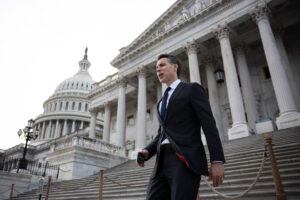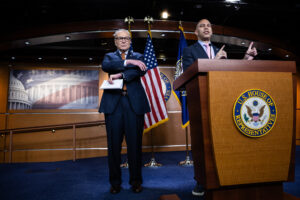The Dictatorship
McDonald’s is clowning itself with its DEI rollback

During the height of the racial justice protests that came after Minneapolis police murdered George Floyd, McDonald’s joined the fray of businesses and institutions declaring their solidarity with all those committed to ending racism. In a post on June 3, 2020on the platform then known as Twitter, McDonald’s shared a short video listing Floyd’s name alongside other Black victims of violence, including Trayvon Martin and Atatiana Jefferson.
McDonald’s announced this week that it’s stepping away from its previously established DEI goals.
In muted red and yellow tones, the video read: “He was one of us; she was one us,” and continued that the “entire McDonald’s family grieves.” McDonald’s declared itself in solidarity with “victims of systemic oppression,” and made it clear that the corporation stands “with Black communities.” It offered as proof its donations to the Urban League and the NAACP. The video ended with a black screen with white letters: “Black lives matter.”
It’s unlikely that McDonald’s will be posting a similar video anytime soon. McDonald’s announced this week that it’s stepping away from some of its previously established DEI goalsretiring a specific DEI pledge and changing the way it refers to its diversity team.
The gestures made during the summer of 2020 appear to have been compelled more by peer pressure than by principle. Now, leaders of organizations from big-box stores to universities have publicly disavowed policies promoting diversity, equity and inclusion, whose acronym DEI has become shorthand for any and all attempts to address centuries of homogeneity, inequality and exclusion in educational and professional spaces.
In other sectors, leadership and development support programs for racial and ethnic minorities have been renamed, restructured or simply retired. And in light of the Supreme Court curtailing affirmative action in higher education and a concerted conservative onslaught on diversity, equity and inclusion efforts, McDonald’s frames its move as an attempt to pre-empt further court challenges to its diversity efforts.
In a Jan. 6 open letter to employees and franchisees that acknowledges “the shifting legal landscape,” the company’s senior leadership team announced what it called “a new concept: the power of OUR ‘Golden Rule’ — treating everyone with dignity, fairness and respect, always.” The company says it is:
- “retiring setting aspirational representation goals and instead keeping our focus on continuing to embed inclusion practices that grow our business into our everyday process and operations”
- “pausing external surveys to focus on the work we are doing internally to grow the business”
- “retiring Supply Chain’s Mutual Commitment to DEI pledge in favor of a more integrated discussion with suppliers about inclusion”
- and “evolving how we refer to our diversity team, which will now be the Global Inclusion Team.”
McDonald’s senior leadership said it remains committed to inclusion and believes a diverse workforce is a competitive advantage.
How it distributes its supply contracts not only impacts which companies get the opportunity to stock McDonald’s restaurants with hamburger buns and sausage patties, but it also impacts workers who prepare these essential goods. “Pausing external surveys” means aggrieved employees may have trouble collecting data and information on potentially discriminatory action within the organization.
McDonald’s is among a few corporations that have profited heartily from the idea that they are a friend to Black communities. Long before the summer of 2020, the summer of 1968 (which followed the assassination of Martin Luther King Jr.) spurred soul-searching and reflection about how people in power could be vehicles for social change. Unfortunately, in both eras, many of the proposed solutions pivoted on businesses making commitments to recruit more talent of color while also eyeing the ways that these seemingly pro-social policies could also yield more profits.
McDonald’s has profited heartily from the idea that it is a friend to Black communities.
McDonald’s had already emerged as a dominant presence in the fast-food world, but in the late 1960s, the company would distinguish itself as leader in what would eventually be called DEI. The first step was recruiting its first Black franchisee, Herman Petty, to reopen a store on Chicago’s South Side in December 1968, and enlisting Black regional managers and advisers to build what would be called “Black stores.” A numerically modest but economically impactful group of Black franchise owners introduced and revived the brand among urban consumers of color. McDonald’s devoted an advertising budget to create content exclusively for minority media and recruited Black celebrities like Michael Jordan and Gladys Knight for national campaigns, making the company a leading source of contracts for Black-owned radio and TV networks, as well as marketing and consulting firms.
The McDonald’s logo appeared on material heralding contributions to civil rights organizations, historically Black colleges and universities and cultural initiatives. Many of those actions were initiated and funded by its growing network of Black franchise owners, who tried to hold McDonald’s accountable for contributing to a loyal and critical part of their consumer market.
Forty-four years after the first Black franchise owner entered the McDonald’s system, the chain selected Don Thompsonits first Black CEO, in 2012. That felt like a sign that the Golden Arches could recognize Black talent after decades of touting itself as a diversity champion in its recruitment efforts. Much of the company’s success — from the 1980s until the mid-2000s — was related to the work of Patricia Sowell Harrisa pioneer in the field of corporate diversity who started her early career at McDonald’s as an affirmative action officer in 1985.
In light of the national backlash against discussing the nation’s history or racism, it may not come as much of a surprise to those who don’t know the company’s history that McDonald’s is disavowing DEI. But so much of McDonald’s branding strategy for the last 50 years has promoted the chain as not just a place to eat cheap food served fast but as a supporter of the Black community and Black entrepreneurship.
This thinking and strategy expanded to other communities that gave birth to affinity groups for Latino franchisees, members of the AAPI community, women and LGBTQ people. This was smart business because it was lucrative, but it was also protective business because such demonstrations of appreciating diversity could also be used to deflect serious and important challenges to the labor experiences of its workers, most of whom are people of color.
So much of McDonald’s branding strategy has promoted the chain as a supporter of the Black community and Black entrepreneurship.
In recent years, when Black franchisees have organized and filed lawsuits against McDonald’s claiming racial discrimination related to the assignment of restaurants and alleging a lack support during challenging times such as the Covid-19 shutdowns, McDonald’s was able to argue its bona fides in creating Black wealth through franchises and its internal commitment to diversity.
But with its announcement that it’s retiring certain DEI policies, McDonald’s seems to have concluded that it doesn’t need the diversity talking points anymore, and although it’s one of the most powerful and influential global corporations with a record that speaks volumes about how diversity initiatives have enriched the company, it doesn’t appear to believe that diversity — no matter how superficial — is worth fighting for anymore.
In McDonald’s announcement, the company argued that its “early and full adoption of inclusion gives us a competitive advantage,” which both recognizes and glosses over the dynamic history that McDonald’s has had in DEI and signals that the company hopes the public will use the past to inform the present. But it’s still uncertain what the future will hold for a company that once touted itself to be a fast-food leader and has revealed that, like most corporations, it’s just a self-interested follower.
Marcia Chatelain
Marcia Chatelain is a professor of African American Studies at the University of Pennsylvania and the author of the Pulitzer Prize-winning book “Franchise: The Golden Arches in Black America.”
The Dictatorship
Driver shot in Minneapolis is at least the fifth person killed in US immigration crackdown

The fatal shooting Wednesday of a woman by an immigration officer in Minneapolis was at least the fifth death to result from the aggressive U.S. immigration crackdown the Trump administration launched last year.
The Department of Homeland Security said the officer fired in self-defense as 37-year-old Renee Nicole Macklin Goodtried to run down officers with her vehicle. Minneapolis Mayor Jacob Frey said video of the incident showed it was reckless and unnecessary. It occurred as the federal agency escalates immigration enforcement operations in Minnesota by deploying an anticipated 2,000 agents and officers.
Last September, Immigration and Customs Enforcement fatally shot another person outside Chicago. Two people have died after being struck by vehicles while fleeing immigration authorities. And a California farmworker fell from a greenhouse and broke his neck during an ICE raid last July.
No officers or agents have been charged in the deaths.
Stay up to date with the news and the best of AP by following our WhatsApp channel.
Cook from Mexico shot during a traffic stop
ICE agents fatally shot Silverio Villegas González during a traffic stop Sept. 12 in suburban Chicago. Relatives said the 38-year-old line cook from Mexico had dropped off one of his children at day care that morning.
At the time, the Department of Homeland Security said federal agents were pursuing a man with a history of reckless driving who entered the country illegally. They alleged Villegas González evaded arrest and dragged an officer with his vehicle.
Homeland Security said the officer opened fire fearing for his life and was hospitalized for “serious injuries.” However, local police body camera videos showed the agent who shot Villegas González walking around afterward and dismissing his own injuries as “nothing major.”
Homeland Security has said the death remains under investigation.
Another shooting, this one non-fatal, occurred in Chicago last fall. Marimar Martinez survived being shot five times by a Border Patrol agent but was charged with a felony after Homeland Security officials accused her of trying to ram agents with her vehicle. The case was dismissed after videos emerged that Martinez’s attorneys said showed an agent steering his vehicle into Martinez’s truck.
Farmworker fell from greenhouse roof during ICE raid
Immigration authorities were rounding up dozens of farmworkers July 10 at Glass House Farms in southern California when Jaime Alanis fell from the roof of a greenhouse and broke his neck. The 57-year-old laborer from Mexico died at a hospital two days later.
Relatives said Alanis had spent a decade working at the farm, a licensed cannabis grower that also produces tomatoes and cucumbers, located in Camarillo about an hour east of Los Angeles. They said he would send his earnings to his wife and daughter in Mexico.
During the raid, Alanis called family to say he was hiding. Officials said he fell about 30 feet (9 meters) from the greenhouse roof.
The Department of Homeland Security said Alanis was never in custody and was not being chased by immigration authorities when he climbed onto the greenhouse.
Man struck on California freeway after running from Home Depot
A man running away from immigration authorities outside a Home Depot store in southern California died after being hit by an SUV while he tried to cross a nearby freeway on Aug. 14.
Police in Monrovia northeast of Los Angeles said ICE agents were conducting enforcement operations when the man fled on foot to Interstate 210. He was running across the freeway’s eastbound lanes when an SUV hit him while traveling 50 or 60 mph miles (80 or 97 kph). He died at a hospital.
The man killed was later identified by the National Day Laborer Organizing Network as 52-year-old Roberto Carlos Montoya Valdez of Guatemala.
The Department of Homeland Security said Montoya Valdez wasn’t being pursued by immigration authorities when he ran.
Gardener from Honduras killed on Virginia interstate
A pickup truck fatally struck Josue Castro Rivera on a highway in Norfolk, Virginia, as he tried to escape immigration authorities during a traffic stop Oct. 23.
Castro Rivera, 24, of Honduras, was heading to a gardening job with three passengers when ICE officers pulled over his vehicle, according to his brother, Henry Castro.
State and federal authorities said Castro Rivera ran away on foot and was hit by a pickup truck on Interstate 264.
The Department of Homeland Security said Castro Rivera’s vehicle was stopped as part of a “targeted, intelligence-based” operation and that Castro Rivera had “resisted heavily and fled.”
His brother said Castro Rivera came to the U.S. four years earlier and worked to send money to family in Honduras.
___
AP journalists Sophia Tareen in Chicago and Michael Biesecker in Washington contributed. Bynum reported from Savannah, Georgia.
The Dictatorship
ICE STORM: AGENT KILLS AMERICAN

MINNEAPOLIS (AP) — An Immigration and Customs Enforcement officer shot and killed a Minneapolis driver on Wednesday during the Trump administration’s latest immigration crackdown on a major American city — a shooting that federal officials said was an act of self-defense but that the mayor described as reckless and unnecessary.
The 37-year-old woman was shot in the head in front of a family member in a snowy residential neighborhood south of downtown Minneapolis, just a few blocks from some of the oldest immigrant markets and about a mile (1.6 kilometers) from where George Floyd was killed by police in 2020.
Her killing after 9:30 a.m. was recorded on video by witnesses, and the shooting quickly drew a large crowd of angry protesters. By evening, hundreds were there for a vigil to mourn her death and urge the public to resist immigration enforcers.
Crowds gathered in Minneapolis on Wednesday as they protested and held a vigil for a woman killed during the Trump administration’s latest immigration crackdown. (AP video shot by: Mike Householder)
The woman, Renee Nicole Macklin Good, had a 6-year old child, her mother told the Minnesota Star Tribune. Macklin Good described herself on social media as a “poet and writer and wife and mom” who was from Colorado.
Videos taken by bystanders with different vantage points and posted to social media show an officer approaching an SUV stopped across the middle of the road, demanding the driver open the door and grabbing the handle. The Honda Pilot begins to pull forward and a different ICE officer standing in front of the vehicle pulls his weapon and immediately fires at least two shots into the vehicle at close range, jumping back as the vehicle moves toward him.
It is not clear in the videos if the vehicle makes contact with the officer and there is no indication of whether or not the woman had interactions with ICE officers before the videos started. After the shooting, the SUV speeds into two cars parked on a curb nearby before crashing to a stop.
Stay up to date with the news and the best of AP by following our WhatsApp channel.
In another video taken at the scene, a woman, who described Macklin Good as her spouse, is seen crying near the vehicle. The woman, who was not identified, said the couple had only recently arrived in Minnesota and that they had a child.
“Our officer followed his training, did exactly what he’s been taught to do in that situation,” Homeland Security Secretary Kristi Noem said at a news conference in Minneapolis Wednesday evening.
Homeland Security Secretary Kristi Noem described the incident as an “act of domestic terrorism” carried out against ICE officers by a woman who “attempted to run them over and rammed them with her vehicle. An officer of ours acted quickly and defensively, shot, to protect himself and the people around him.”
In a social media post, President Donald Trump made similar accusations against the woman and defended ICE’s work.
Local officials dispute the narrative
Noem claimed the woman was part of a “mob of agitators” and said the officer followed his training. She said the veteran officer who fired his gun had been rammed and dragged by an anti-ICE motorist in June.
“Any loss of life is a tragedy, and I think all of us can agree that in this situation, it was preventable,” Noem said, adding that the FBI would investigate.
But Minneapolis Mayor Jacob Frey blasted Noem’s version of what happened as “garbage” and criticized the federal deployment of more than 2,000 officers to the Twin Cities of Minneapolis and St. Paul as part of the immigration crackdown.
“What they are doing is not to provide safety in America. What they are doing is causing chaos and distrust,” Frey said, calling on the immigration agents to leave. “They’re ripping families apart. They’re sowing chaos on our streets, and in this case, quite literally killing people.”
“They are already trying to spin this as an action of self-defense. Having seen the video myself, I wanna tell everybody directly, that is bullshit,” the mayor said.
AP AUDIO: Minneapolis mayor says ICE officer’s killing of a motorist was ‘reckless’ and wasn’t self-defense
AP’s Lisa Dwyer reports on a fatal shooting in Minneapolis by federal agents.
Shooting is fifth linked to crackdowns
The shooting marked a dramatic escalation of the latest in a series of immigration enforcement operations in major cities under the Trump administration. The death of the woman in Minneapolis was at least the fifth linked to immigration crackdowns.
The Twin Cities have been on edge since DHS announced Tuesday that it had launched the operation, which is at least partly tied to allegations of fraud involving Somali residents. Name said they had already made “hundreds and hundreds” of arrests.
A large throng of protesters gathered at the scene after the shooting, where they vented their anger at the local and federal officers who were there, including Gregory Bovinoa senior U.S. Customs and Border Patrol official who has been the face of crackdowns in Los Angeles, Chicago and elsewhere.
“She was driving away and they killed her,” said Lynette Reini-Grandell, a local resident who was among those who filmed the shooting.
In a scene that hearkened back to the Los Angeles and Chicago crackdowns, bystanders heckled the officers, chanting “ICE out of Minnesota” and blew whistles that have become ubiquitous during the operations.
Governor calls for calm
Minnesota Gov. Tim Walz said he’s prepared to deploy the National Guard if necessary. He described the killing as “predictable” and “avoidable.” He also said like many, he was outraged by the shooting, but he called on people to keep protests peaceful.
“They want a show. We can’t give it to them. We cannot,” the governor said.
Minneapolis Public Schools canceled school, sports and activities for Thursday and Friday, saying in a statement that the decision was “due to safety concerns related to today’s incidents around the city.”
Minneapolis Police Chief Brian O’Hara briefly described the shooting to reporters but, unlike federal officials, gave no indication that the driver was trying to harm anyone.
There were calls on social media to prosecute the officer who shot the driver. Commissioner Bob Jacobson of the Minnesota Department of Public Safety said state authorities would investigate the shooting with federal authorities.
“Keep in mind that this is an investigation that is also in its infancy. So any speculation about what has happened would be just that,” Jacobson told reporters.
The shooting happened in the district of Democratic Rep. Ilhan Omar, who called it “state violence,” not law enforcement.
For nearly a year, migrant rights advocates and neighborhood activists across the Twin Cities have been preparing to mobilize in the event of an immigration enforcement surge. From houses of worship to mobile home parks, they have set up very active online networks, scanned license plates for possible federal vehicles and bought whistles and other noisemaking devices to alert neighborhoods of any enforcement presence.
___
Dell’Orto reported from St. Paul, Minnesota. Associated Press reporters Steve Karnowski in Minneapolis, Ed White in Detroit, Valerie Gonzalez in Brownsville, Texas, Mark Vancleave in Las Vegas, Michael Biesecker In Washington and Jim Mustian in New York contributed.
The Dictatorship
What RFK Jr. and the USDA’s new food pyramid get wrong
ByBrian Kateman
The Trump administration unveiled dietary guidelines this week that flip the food pyramid Americans have known for decades, encouraging greater consumption of protein, particularly meat and dairy.
That’s not exactly what the average American, who already eats 227 pounds of meat a year, needs to hear. The recommendations, the latest work of the Make America Healthy Again movement of Health and Human Services Secretary Robert F. Kennedy Jr., actually puts health at greater risk.
The new nutrition recommendations actually put health at greater risk.
For one thing, protein is among the few nutrients in which most Americans are not deficient. Health experts widely agree that most of us eat much more protein than necessary. The new pyramid illustration includes a big hunk of steak and a package of ground beef at the top; never mind, apparently, that the American Cancer Society considers red meat to be “probably carcinogenic to humans.” The American Heart Association has long advised people to limit consumption of red meat because of its deleterious health effects, including as a contributor to heart disease.
In an event Thursday with Agriculture Secretary Brooke Rollins promoting the revised nutrition policy, Kennedy referred to the heart association as a “big villain.” In Kennedy’s telling, the organization “continues to accept millions of dollars from the biggest processed food makers in this country.” Doing so, he argued, “fortified a dogma that vilified and demonized good food.”

The new nutrition guidelines also recommend full-fat dairy, directly contradicting the heart association’s recommendation of reduced-fat options, such as fortified plant-based milk alternatives.
Cancer, heart disease and diabetes are among the leading causes of death and drivers of health care costs in the United States, according to a different federal agency, the Centers for Disease Control and Prevention. The USDA nutrition guidelines say they target those same chronic illnesses but promote the high-fat, high-cholesterol foods that study after study shows contribute to them.
Ultimately, this isn’t just bad advice; it’s also dangerous to public health and the planet.
The slogan of the guidelines is “Eat Real Food,” which is defined as “whole, nutrient-dense, and naturally occurring.” Putting aside that animal products — most of which come from factory farms — are arguably the most processed foods on Earth, the only thing about these guidelines that’s significantly different from past pyramids is the emphasis on meat and dairy. This happens to be the opposite of the advice of virtually every credible health-related organization.

The Department of Agriculture may put out nutritional guidelines, but it’s worth remembering that it isn’t a medical body — it represents farm operations, including cattle ranchers and dairy farmers. As Kennedy said on Thursday, “It’s important that the American people know that sometimes they are getting medical advice from people who have an economic stake in that advice, and we have a responsibility to question that.”
Indeed. The USDA has been accused of having a revolving door for lobbyists and of promoting the interests of industry over public health. In October, Rollins announced a battery of plans to “strengthen the American beef industry, reinforcing and prioritizing the American rancher’s critical role in the national security of the United States.” What beef has to do with national security, I can’t say, but Americans’ health clearly isn’t the only priority of the Trump administration.
To be fair, dietary guidelines have often been shaped by corporate interests.
To be fair, dietary guidelines have often been shaped by corporate interests. In the mid-20th century, global attention to a “protein gap” in developing countries led the United Nations to establish a Protein Advisory Groupwhich promoted Western nutritional ideas and helped create markets for surplus food exports. By the 1970s, experts recognized that the real problem was not protein deficiency but a lack of sufficient calories. Companies such as Nestlé profited from these international nutrition programs, raising questions about the influence of industry on dietary advice.
Now the U.S. government is effectively pushing another protein panic. A lot of nutritional science is more up in the air than many might think, but this is an area where medical authorities have some consensus. There’s just no basis for the claim that Americans need more protein, and certainly not from animal sources. It’s not just the American Heart Association pointing in the exact opposite direction.
There’s just no basis for the claim that Americans need more protein, and certainly not from animal sources.
And decades’ worth of scientific evidence shows the deleterious effects of industrial animal agriculture on the health of the planet. It’s a major contributor to climate change, putting people around the world at greater risk of extreme weather events, respiratory illnesses, heat-related illnesses, insufficient access to clean water and exposure to water-borne disease. In a sad irony, climate change threatens our food systems and limits the amount of decent food humans are able to produce. Agricultural practices in the meat industry have made it a vector for disease and have led to mass outbreaks of illness.
Dietary guidelines shape school luncheshospital meals, public assistance programs and more, including the advice given to millions of people who do not have the luxury of opting out. When federal guidance elevates red meat and full-fat dairy — foods long associated with higher rates of cancer, heart disease, diabetes and environmental harm — the costs are shouldered by poorer families, many already struggling with chronic illness, and by communities facing a warming planet.
This isn’t just a technical disagreement about nutrition; it’s a choice about whose interests public policy serves. And in this case, the answer is not the health of the American public but the balance sheets of meat and dairy companies. Such is the price of Making Agribusinesses Happy Again.
Brian Kateman
Brian Kateman is a co-founder and the president of the Reducetarian Foundation, a nonprofit organization dedicated to reducing consumption of meat, eggs and dairy to create a healthy, sustainable and compassionate world. He is the author of “Meat Me Halfway” — inspired by a documentary of the same name — and the editor of “The Reducetarian Cookbook” and “The Reducetarian Solution.” He is an adjunct professor of environmental science and sustainability at Kean University and teaches environmental communications at Fordham University.
-

 The Dictatorship11 months ago
The Dictatorship11 months agoLuigi Mangione acknowledges public support in first official statement since arrest
-

 The Dictatorship4 months ago
The Dictatorship4 months agoMike Johnson sums up the GOP’s arrogant position on military occupation with two words
-

 Politics11 months ago
Politics11 months agoBlue Light News’s Editorial Director Ryan Hutchins speaks at Blue Light News’s 2025 Governors Summit
-
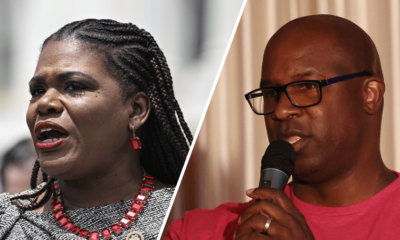
 Politics11 months ago
Politics11 months agoFormer ‘Squad’ members launching ‘Bowman and Bush’ YouTube show
-
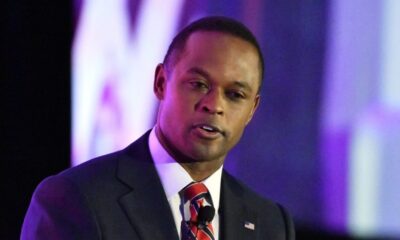
 Politics11 months ago
Politics11 months agoFormer Kentucky AG Daniel Cameron launches Senate bid
-

 The Dictatorship11 months ago
The Dictatorship11 months agoPete Hegseth’s tenure at the Pentagon goes from bad to worse
-
Uncategorized1 year ago
Bob Good to step down as Freedom Caucus chair this week
-
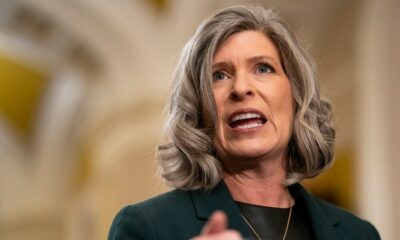
 Politics9 months ago
Politics9 months agoDemocrat challenging Joni Ernst: I want to ‘tear down’ party, ‘build it back up’





